
Receiver for Baudot Multiplex type-printing telegraph, 1911-1925






Receiver for Baudot Multiplex type-printing telegraph, made by the Automatic Telephone Manufacturing Company, Edge Hill, Liverpool, England, 1911-1925.
The Baudot code was a five-bit code developed for telegraphy. The wheel of this printer was kept constantly revolving using an external motor, while the five relays at the top of the machine selected the symbol to be printed, depending on the signal that they received from the distant transmitting keyboard and distributor. The paper tape was put into contact with the type wheel as soon as a signal was received, printing the message.
Details
- Category:
- Telecommunications
- Object Number:
- 1925-85
- Materials:
- brass (copper, zinc alloy), steel (metal), metal (unknown), textile and paper (fibre product)
- type:
- telegraph
- credit:
- Donated by Siemens Group Services Limited




